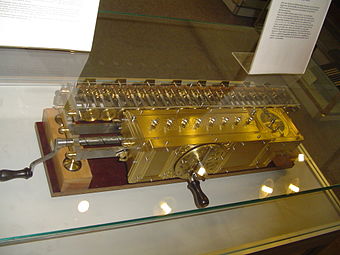
... it is beneath the dignity of excellent men to waste their time in calculation when any peasant could do the work just as accurately with the aid of a machine.
— Gottfried Leibniz[1]
The stepped reckoner or Leibniz calculator was a mechanical calculator invented by the German mathematician Gottfried Wilhelm Leibniz (started in 1673, when he presented a wooden model to the Royal Society of London[2] and completed in 1694).[1] The name comes from the translation of the German term for its operating mechanism, Staffelwalze, meaning "stepped drum". It was the first calculator that could perform all four basic arithmetic operations.[3]
Its intricate precision gearwork, however, was somewhat beyond the fabrication technology of the time; mechanical problems, in addition to a design flaw in the carry mechanism, prevented the machines from working reliably.[4][5]
Two prototypes were built; today only one survives in the National Library of Lower Saxony (Niedersächsische Landesbibliothek) in Hanover, Germany. Several later replicas are on display, such as the one at the Deutsches Museum, Munich.[6] Despite the mechanical flaws of the stepped reckoner, it suggested possibilities to future calculator builders. The operating mechanism, invented by Leibniz, called the stepped cylinder or Leibniz wheel, was used in many calculating machines for 200 years, and into the 1970s with the Curta hand calculator.
- ^ a b Kidwell, Peggy Aldritch; Williams, Michael R. (1992). The Calculating Machines: Their history and development. MIT Press., pp. 38–42, translated and edited from Martin, Ernst (1925). Die Rechenmaschinen und ihre Entwicklungsgeschichte. Germany: Pappenheim.
- ^ Liebezeit, Jan-Willem (July 2004). "Leibniz Rechenmaschinen". Friedrich Schiller Univ. of Jena.
- ^ Beeson, Michael J. (2004). "The Mechanization of Mathematics". In Teucher, Christof (ed.). Alan Turing: Life and Legacy of a Great Thinker. Springer. p. 82. ISBN 3-540-20020-7.
- ^ Dunne, Paul E. "Mechanical Calculators prior to the 19th Century (Lecture 3)". Course Notes 2PP52:History of Computation. Computer Science Dept., Univ. of Liverpool. Retrieved 2008-01-21.
- ^ Noll, P. (2002-01-27). "Gottfried Wilhelm Leibniz". Verband der Elektrotechnik Electronik Informationstechnic e.V. (Association for Electrical, Electronic and Information Technologies). Archived from the original (PDF) on January 8, 2008. Retrieved 2008-01-21.
- ^ Vegter, Wobbe (2005). "Gottfried Wilhelm von Leibniz". Cyber heroes of the past. hivemind.net. Retrieved 2008-01-21.